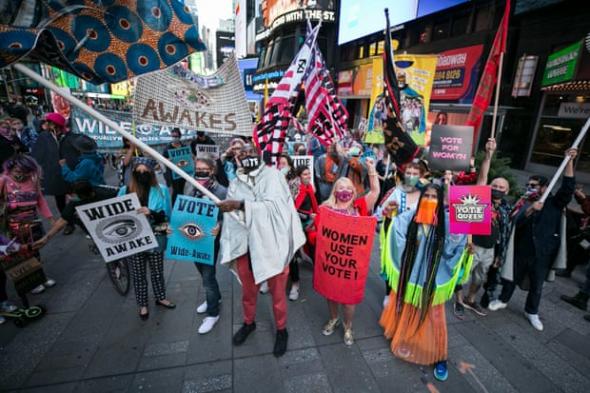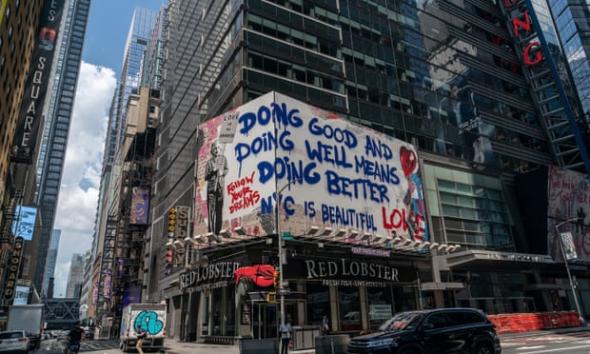How Times Square became an unlikely hub for resistance art
Since the start of the pandemic, one of the busiest tourist attractions in New York City has found itself dominated by artists with a message. A billboard illustrating the killing of George Floyd hangs in Times Square. Photograph David Dee Delgado, Getty Images
A billboard illustrating the killing of George Floyd hangs in Times Square. Photograph David Dee Delgado, Getty Images
For 20 years, Fran Lebowitz has been dreaming of tourists disappearing from Times Square. “Now there are no tourists in Times Square,” she recently said, “but, of course, there’s no one in Times Square.”
When the pandemic hit in March, Times Square went from a congested, and hellish, hub for tourists to an eerily empty dystopia. More recently, though, it has become a site of artistic expression, taken over by a free fall of protest art, colorful parades and performances.
“It lacks the same history of worker organization spaces like Union Square, but with the spread of digital graphics and art during the Covid-19 pandemic and black-led uprisings, Times Square has made itself a unique site for protest in a city with more empty space, and an ongoing stream of creative mobilizations,” said Sarah J Seidman, a curator at the Museum of the City of New York.
Just last month, Brooklyn artist Don Perlis created a painting of George Floyd with the police officer kneeling on his throat, which has been blown up into a giant billboard with a quote from the Dalai Lama, which reads: “Be kind whenever possible, it is always possible.” It’s part of a series spearheaded by the George Floyd Justice Billboard Committee (the chairwoman is Corinne Innis, daughter of civil rights leader Roy Innis).
“Picasso said: ‘Art is a weapon,’ and the painting of George Floyd is a plea for justice and kindness,” said Perlis. “We hope this can help to bring people together and help bring about profound change so this kind of thing will never happen again.”
Times Square could be the perfect place to shed light on such a pressing issue. “We hoped putting the billboard in the so-called ‘Crossroad of the World’ would remind people of our common humanity and of the need for change,” adds the artist.
 The Vote Feminist Art Parade is organized by artist Michele Pred collaboration with the wideawakes.com and The Berkeley Art Museum. Photograph Pontus Höök
The Vote Feminist Art Parade is organized by artist Michele Pred collaboration with the wideawakes.com and The Berkeley Art Museum. Photograph Pontus Höök
The district saw many colorful protests this summer. Ebony Brown, a founding member and participant in the Wide Awakes, a group spearheaded by For Freedoms co-founder Hank Willis Thomas, worked to commemorate the 160th anniversary of the namesake, Lincoln-era abolitionist group for a ‘Juneteenth Jubilee’, which lasted all summer. The group also put on a Vote Feminist Art Parade last month which took over the area with vibrancy and urgency.
“People needed to laugh, dance and sing, even if they were masked and socially distancing,” said Brown. While New Yorkers typically avoid Times Square for its crowds and general garishness, it still brought the political performance artists.
“Ultimately, what we created was performance art, it just happened to be an act of multicultural, civic engagement,” she said. “We shut down Broadway on a Saturday night, reclaiming the streets in the name of all the lives stolen by racial violence and police brutality.”
Another group that rallied for art workers came out for Be An Arts Hero, a national ‘day of action’ on Labor Day for creative workers affected by the pandemic – especially the Broadway staff. Over a hundred people gathered in Times Square, from choreographers to costume designers, to sing Will I? from the musical Rent (the lyrics go: “Will I lose my dignity? Will someone care?”).
“It was an opportunity to start to change the conversation around arts work,” Jenny Grace Makholm, an organizer with the group. “Times Square is the heartbeat of the Broadway community, the soul of New York’s theater district, and just as the arts has been devastated by this crisis, so has Times Square.”
New York artist Andy Golub recently held his seventh annual Bodypainting Day in Times Square, which was significantly different from its past tradition of parading stripped down performers, which got the artist arrested in 2011 (“but things have been settled since then,” says the artist).
“Many people think that performance art, like bodypainting, is all about getting attention, but it’s really about bringing people together,” he said.
 Mr. Brainwash art on billboards at Times Square. Photograph Lev Radin, Pacific Press, REX, Shutterstock
Mr. Brainwash art on billboards at Times Square. Photograph Lev Radin, Pacific Press, REX, Shutterstock
Granted, there has always been art in Times Square, from Spencer Tunick’s group shots of nudes, to Public Art Fund projects and the ongoing series with Times Square Arts but of late, it’s multiplied, with more advertising space, recently taken over by the digital billboard campaign to honor and thank essential workers called Messages for the City. This summer also saw French street artist Mr Brainwash (the moniker for Thierry Guetta), host a series of banners and murals on the side of a building, with phrases like: “We are all in this together” and “Love is the answer”.
There’s a rotating cast of video art, too, on the screens as part of the Midnight Moment series – a lovely break from the onslaught of ads – from watching people sleeping, eating or dancing. It also is a place to scream one’s own opinion, like where the Lincoln Project recently mounted digital billboards featuring Jared Kushner and Ivanka Trump.
And individual creators, like costume designer Claire Zhang, who recently wore her Marie Antoinette-esque gown to Times Square, continue to challenge conventions. “The importance of using Times Square as a site for protest and pandemic art is to raise people’s awareness of the diversity of this city, and to make them feel more connected to the world,” said Zhang.
Despite all its pitfalls, it’s still a place where artists go to be heard. “With tourism having virtually disappeared from the city, it was an opportunity to send the message that New York City is resilient and that our creative spirit can’t be broken,” adds Golub.
Indeed, the spirit of the city could be captured in this chaotic flickering part of midtown. “I think, in many ways, Times Square represents America,” he said. “It can be pretty extreme at times, whether it’s increasing crime or excessive commercialism, but it’s also a place where freedom of expression thrives.”
While it’s clear that Times Square will always remain problematic to locals (like Lebowitz, for example), it will always be a hub for something. “It may not be the heart of New York, but it’s the face,” said Golub. “Right now, things are a little tough, but we are resilient. It’s the role of the artists to keep following their vision and celebrate life, especially when things are challenging.”
Article originally published by The Guardian in 04/11/2020